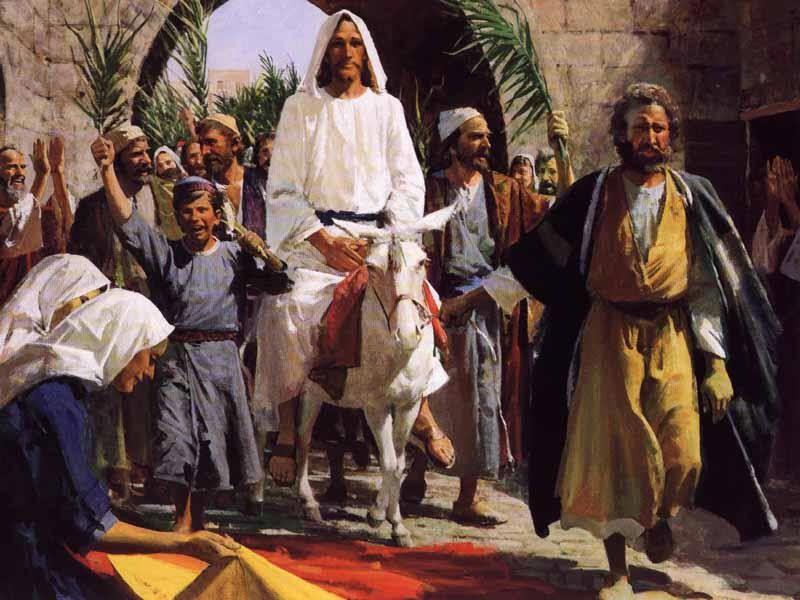John – Chapter 12
The twelfth chapter of John falls into four divisions: (1) the supper for Jesus and Lazarus (John 12:1-11); (2) the triumphal entry (John 12:12-20); (3) coming of the Greeks, and the voice from heaven (John 12:21-36); and (4) Jesus sums up his claims (John 12:37-50).
Let’s continue our journey through the Gospel of John, and we are in chapter 12. We see that this is the last chapter in what is referred to as the ‘Book of Signs’. The ‘Book of Signs’, chapters one through twelve, focuses in a very clear structure around seven miracles and responses as well as narrative discourses. Usually the responses are afterwards, although in chapter 11 we noticed that John reversed the order and had the discourse before the raising of Lazarus. The important thing to note is that when Jesus says, “I am the resurrection and the life,” and then He follows that up with the resurrection of Lazarus, that is an important power. When He says, “I am the light of the world,” and gives sight to the man born blind, when he makes these claims He always verifies them and backs them up. These are not just claims that are empty. One of the things about Jesus’ life is that His words and His works were perfectly congruent. There was a complete integrity between the two.
So, His claims and His credentials actually reinforce one another. That is why belief in Christ, when we look at the real evidence, instead of the deconstructionism among many liberal theologians today, which is not warranted by history, by the manuscript evidence or by the early Church. All these are later and modern theories imposed on the text. My argument is actually a simple analysis of the Gospels as primary historical documents demonstrate that belief in Christ is not a leap in the dark, but a step that is into the light. A step it is, though, and it is not going to just be automatic.
A step is required, as we will see in this material. In John chapter 12, in fact, Jesus is going to have a discourse at the very end and it is His last public words. It is an exhortation, and an appeal to the people to respond because after that. Beginning in chapter 13 and through chapter 17, we have Jesus only with His disciples in the Upper Room and then after that the narrative completes the story with the Passion and the Resurrection and the post-resurrection appearances of our Lord. That is the general structure of John’s Gospel. It is highly selective material. Let’s look at chapter 12, remembering that it is important to know that these chapter divisions are generally good, but not always the best. There is integrity between one verse and the next. They were not, originally, divided into either verses or chapters. In fact, they didn’t even have punctuation.
Six days before the Passover, Jesus came to Bethany where Lazarus was, whom He had raised from the dead. So they made Him a supper there and Martha was serving. Mary took a pound of very costly perfume of pure nard, and anointed the feet of Jesus and wiped His feet with her hair; and the house was filled with the fragrance of perfume.” Let me stop here for just a moment. I have just argued that there have been many correlative witnesses and truths throughout, but Mary is seen as the culmination of Jesus’ message. What is significant here is that this woman demonstrates greater understanding of the mission of Jesus than did His own disciples. His disciples did not really grasp or understand what He was really about. Jesus made it clear to them that only after the resurrection did they “Understand the things He had told them.” Then they understood how it all connected. The idea of what He was really intending to do was so radical that really no one on this earth could have made it up. That is why there is no other religion that has the idea that God suffers for us. That is because it is too radical for a person to make up. In particular, there is no religion that says there is grace through faith and not by any merit or attainment of our own but it is a gift of God. These are unique things because they are products of God and not human imagination. In fact, that uniqueness is, in my view, one of the evidences for the truth of Christianity. There is nothing like it in the world. This is not something people would have made up. That is why His own disciples misunderstood His mission. It was more radical than anyone could have imagined at that point.
The interesting thing with Mary anointing His feet, and we know from the parallel Gospels that she also anointed His head, is that it is an interesting moment for several reasons. One of them is that she fulfilled Jesus’ words, that we ought to wash the feet of one another, even before He uttered those words. There is a clear and evident parallelism here that we are invited to see. Let me make a comment. The other Gospels mention they were at the home of Simon the leper. Chances are that might have been the home he owned but it doesn’t say he was actually there. It is also possible that might have been Martha’s home and that she was the hostess for this event. It is difficult to say, but we do know that Martha is fulfilling her customary role here where she is busy serving and Mary is worshiping. The three times we see Mary with Jesus she is at His feet.
We are continuing in our study of the Gospel of John. Last week we discussed the story of the raising of Lazarus in chapter 11. Many scholars think that originally chapters 11 and 12 of John’s gospel were not originally together because the beginning of ch. 12 is not very smooth. Why would you have to identify Lazarus so soon after telling the story of his resurrection? I think biblical scholars may make too much of this. It is not uncommon in literature to repeatedly identify certain characters. Clearly there was a passage of time between these stories originally. In ch. 11, Jesus withdrew to a small town called Ephraim to avoid the authorities. He returns to Bethany in ch. 12.
The text indicates that the reason Jesus returned to Bethany was that it was almost Passover, and he wanted to be one of the estimate 100,000 pilgrims to Jerusalem for the festival. Ch. 11 ended with the crowds discussing whether Jesus would dare come to Jerusalem for the festival. On his way to Jerusalem Jesus returns to Bethany, where Lazarus and his sisters lived, and a dinner was given for Jesus. Translators make the assumption that the dinner was given by Lazarus since Martha was serving the meal, but the Greek text has no subject. All we know is that a dinner was given in Jesus’ honor, that Lazarus was at the table with him, and Martha was serving. It makes perfect sense in the context of the Gospel that this was a dinner given for Jesus in gratitude for having raised Lazarus from the dead. The tableau of Lazarus at the table with Jesus completes the story of his resurrection. Lazarus has been fully restored and is able to share in a celebratory meal. But, as we shall see, this story also anticipates the Last Supper. This becomes a farewell dinner. The evangelist tells us plainly that by returning to Bethany, Jesus is heading towards his arrest.
Mark and Matthew both tell a story about a dinner held two days before Passover in the home of Simon the Leper, whom Jesus had healed. An unnamed woman pours nard on Jesus head. Someone protests about the waste of valuable ointment when it could have been sold to feed the poor, and Jesus defends the woman, stating that she has anointed him for burial. It appears that John is describing the same incident, but many of the details are different. First, there is no mention of Simon the Leper in John’s account. Certainly, it is possible that the dinner was held at the home of Simon and that Lazarus and his sisters were among the honored guests, but we do not know for sure that is the case. Another difference is that the dinner is six days before Passover in John but is only two days before in Mark and Matthew. It is possible that this was just a minor variation in oral tradition, but it could be that John placed the story six days before in order to draw a parallel to the six days of creation in Genesis. The process of redemption – or re-creation began with the anointing. We have seen many parallels to Genesis in John’s gospel already.
The biggest difference between the anointing in John and in Mark is that the woman in Mark anoints Jesus’ head, but Mary anoints his feet. It is really hard to confuse feet and head. John knew better than we do that it was strange to anoint someone’s feet at a dinner part. Pouring oil on one’s hair was a common practice before a party. It would have been a little odd to have someone do that while you are sitting at a dinner table, but it was not unheard of. The scene in Mark’s gospel makes sense. A wealthy, sinful woman pours expensive perfume on his hair to honor him. Theologically, anointing the head makes sense since anointing was part of the coronation ceremony of the king. To pour perfume on someone’s feet is more than a little odd.
Feet Luke tells a story about a sinful woman at the home of a man named Simon who lived in Galilee, not Judea. She cries on Jesus’ feet and wipes the tears away with her hair, and then she anoints his feet with perfume. This also makes sense, even though it would have been scandalous. We have a picture of humility and tenderness, but only a prostitute would have taken her hair down in public. Add to that what psychologists and anthropologists tell us about the symbolism of the feet, and it is a rather racy story in Luke. It recalls quite strongly the story of Ruth uncovering the feet of Boaz.
The big question is whether Luke and Mark are telling two versions of the same event, with the location changed in Luke, or was these two different events. Did two different women at two different dinners in two different towns pour perfume on Jesus – one on his head, the other on his feet? Or were there two different versions of this story in the oral tradition and each gospel writer craft his own account? To complicate things further, the anointing in John is very similar to a story about Martha and Mary recorded in Luke’s Gospel. Martha was serving dinner while Mary was “sitting at the feet of Jesus.” Mary is criticized, and Jesus defends her. Technically, that is just what happens here in John. Martha is serving dinner. Mary is sitting at Jesus feet because she was anointing them. Jesus defends her for doing so. It is hard to know for sure which of these stories is the closest to the historical event or events, but clearly there were at least two stories: one about Mary at the feet of Jesus and one about a woman anointing Jesus before Passover. Luke handles the stories in one way; John in another.
But, why anoint Jesus’ feet rather than his head? In Luke, it was because the woman was penitent and humble, but the meaning is probably different in John. Mary of Bethany is never described as a prostitute. She is a disciple. The verb used to describe her wiping Jesus’ feet is the same verb used to describe what Jesus does at the last supper to his disciple’s feet. In other words, the disciple Mary is performing for Jesus the same task that he will perform for the Twelve later in the week. If this is historically accurate, we could conclude that Jesus got the idea of washing his disciples’ feet from Mary of Bethany. It was such an act of devotion and love that he was moved to teach all of his disciples to act to each other as Mary had acted toward him.
There is another reason for anointing the feet. As with the story in Mark and Matthew, Jesus says that the woman has anointed him prior to his burial. In John says that “she bought it so that she might keep it for the day of my burial” (NRSV). It is an odd statement since Jesus was not being buried that day, but it does point to his impending death. The meaning appears to be that Mary had been saving the anointment for his burial, but chose to use it at the celebratory dinner. It may even have been left-over from anointing her brother’s body. John presses the point about Jesus burial by having Mary anoint Jesus’ feet. The only time you would do that would be for burial. This anointing at Bethany foreshadows the events to come and provides an elegant transition from the book of Signs to the story of the passion. Lazarus has left the tomb, but now Mary is anointing Jesus for his burial.
Nard The ointment Mary used was made of nard, not myrrh. The text says myron, but that can be a generic word for perfumed oil. John emphasizes that it was genuine spikenard. The nard plant only grows in northern India, so it was a very expensive import in Palestine. A pound of nard was a lavish gift that should not be wasted, but it appears that Mary used it all on Jesus. The fragrance filled the room, removing all memory of the stench of the tomb mentioned in the previous chapter. This is a lovely tableau of Jesus being treated with love and respect by his friends and disciples. It is a foretaste of paradise, but there is a devil in the room.
There is an old saying that no good need goes unpunished, and it is often true that when one person does something kind another will snipe at them. Central to all four accounts of the anointing of Jesus is that the woman is criticized for her actions. In Luke, a Pharisee says that Jesus should not let a woman like that touch him. In Mark and Matthew, the disciples were angry because expensive oil was wasted instead of being sold for the sake of the poor. In John, it is specifically Judas who is angry at Mary. Matthew, Mark, and John all say that the nard was worth at least 300 denarii, which was close to a year’s salary for a common worker. That would feed a lot a people.
This criticism of the woman was deeply ingrained in the oral tradition, probably because it is a valid complaint. When we read the story 1900 years later, we often feel a similar anger. Why would a disciple be so extravagant? If the woman was going to give away so much wealth selflessly for the sake of Jesus, then why not do it in a way that would benefit the poor and suffering? Many times I have heard people condemn someone else’s generosity by pointing out that the money given to the arts, education, and so forth could have been better used for the poor. Rarely have I heard people criticized for spending money on themselves when such money could have been given to the poor. It’s odd, isn’t it? What is the source of such carping? Why try to hurt someone who is trying to be generous? I suspect that it is just envy talking. If I had enough money to waste nard like that, I would certainly give it to the poor. You can imagine the poor disciples resenting the fact that a wealthy woman could do something for Jesus that they could never do, and so one of them ruins this beautiful scene.
John’ Gospel blames this all on Judas. All of the gospels, even the Gospel of Judas, identify him as the disciple who handed Jesus over to the authorities, but over time he was portrayed increasingly bad. By the time Dante wrote the Inferno, Judas was the ultimate villain in the innermost circle of hell. As Raymond Brown says, “The picture of Judas’ cupidity was naturally painted in darker and darker tones as the story was retold.” (Brown, Gospel of John, 453). Since John’s gospel was rather late, it makes sense that his Judas is a villain from the beginning. But there may more to the presence of Judas in this scene than the tendency to develop characters more extremely over time. Judas adds to the foreshadowing of the passion in the anointing. The readers already knew Judas was the betrayer. Rather than rejoicing over the raising of Lazarus and the anointing of Jesus; Judas was angry.
But, there may be even more behind John’s identification of the disgruntled disciple as Judas. Judas means “man of Judea” or even “the Jew.” The focus on Judas may be part of John’s general anti-Semitism that we have discussed many times, or it may reflect the distinctly Judean orientation of his gospel. It was the Judeans who rejected both Mary’s actions and Jesus. Judas claims that he is concerned about the poor, just as Caiaphas claimed to be defending the nation, but Judas’ heart could no longer rejoice with what is good. If you remember your proverbs, Judas is the fly in the ointment that ruins a good deed.
In all four accounts of the anointing, Jesus defends a woman who has been criticized by one of the men present. This is what made this story so memorable for the early church. We should keep this in mind in church when people start grumbling about women ministers or the women’s fellowship. Jesus might tell us, “Leave her alone.” Why does it escape our attention so often that Jesus consistently, insistently, and persistently defended the powerless and abused? Why does it escape our attention that Jesus is never part of the crowd, but is always standing up for what is good and right and true – even at the cost of his life.
It is only John that identifies Judas as the one who was angry, and John also adds the detail that Judas kept the common purse of the disciples. This is one indication that the disciples lived with a common economy – like socialists or fraternity brothers. Income went into a common purse, from which expenses were paid. Historians’ debate whether Judas really was the Chancellor of the Exchequer for the Jesus commune or whether John was just looking for an explanation for what went wrong with Judas. Namely, that the love of money is the root betrayal. The important point John makes is the parenthetical comment that Judas did not care about the poor. He saw the wasted ointment as a wasted opportunity to line his own pockets. Judas is the archetype of the modern politician or preacher who uses moral indignation and self-righteousness to distract the public from his own corruption and venality. Beware of the outraged for they may be trying to steal your wallet!
Unfortunately, in defending Mary, though, Jesus made a statement that has caused a great deal of harm in the church and the world. “You always have the poor with you.” I have heard this verse used dozens of times in both the South and the North as a justification for doing nothing to help the poor. People quote these words of our Lord as a way to avoid doing the works of love that he has commanded us to do. People have misquoted Jesus to justify their own selfishness and greed. Jesus said that there would always be poor people; therefore we should not do anything to alleviate poverty. Instead we should build bigger storehouses for our possessions, we should add to our wealth, we should indulge our every whim and pursue every pleasure. We forget Jesus’ statements about God and Mammon or the rich person and the eye of the needle because we are so comforted by his words to Judas. The poor will always be with you.
What Jesus was doing was reminding Judas and the others of a basic teaching in the Jewish law. There are two categories of good works: works of justice and works of mercy. Works of justice are those things that are required us every day, like being honest. One of the works of justice is to take care of the poor, especially widows and orphans. Jesus was reminding us that we should always take care of the poor, not to ignore them. This is justice. Acts of mercy are things that go beyond what is required of us. Acts of mercy are heroic acts of self-sacrifice and good works. Mary did an act of mercy. She has taken her precious ointment and used it to anoint someone who is not a member of her family. Hers was an extraordinary act worthy of praise, but helping the poor is an ordinary act that we should always do. We should never be content with the knowledge that the poor are always with us.
John ends this story with a report that many Jews had come to the house hoping to see Jesus and Lazarus. This increased the anxiety of the chief priests who were plotting to kill Jesus without arousing the crowds. John is masterful dramatist. The chief priests are plotting and Judas is on the inside angry and resentful. The corrupt priests to betray his friend and teacher will soon recruit the one who claimed he cared for the poor.
All the evangelists record Christ’s riding in triumph to Jerusalem. Many excellent things, both in the word and providence of God, disciples do not understand at their first acquaintance with the things of God. Instead of riding into Jerusalem on a horse, He rode on the back of an ass.
The sin of our souls was the troubled of Christ’s soul, when he undertook to redeem and save us, and to make his soul an offering for our sin. Christ was willing to suffer, yet He prayed to be saved from suffering. Prayer against trouble may well agree with patience under it, and submission to the will of God in it. Our Lord Jesus undertook to satisfy God’s injured honor, and he did it by humbling himself. The voice of the Father from heaven, which had declared him to be his beloved Son, at his baptism, and when he was transfigured, was heard proclaiming that He had both glorified his name, and would glorify it. Christ, reconciling the world to God by the merit of his death, broke the power of death, and cast out Satan as a destroyer. Christ, bringing the world to God by the doctrine of his cross, broke the power of sin, and cast out Satan as a deceiver. The soul that was at a distance from Christ is brought to love him and trust him. Jesus was now going to heaven, and he would draw men’s hearts to him from here after. There is power in the death of Christ to draw souls to him. We have heard from the gospel that which exalts free grace, and we have heard also that which enjoins duty; we must from the heart embrace both, and not separate them.
The people drew false notions from the Scriptures, because they overlooked the prophecies that spoke of Christ’s sufferings and death. Our Lord warned them that the light would not long continue with them, and exhorted them to walk in it, before the darkness overtook them. Those who would walk in the light must believe in it, and follow Christ’s directions. But those who have not faith, cannot behold what is set forth in Jesus, lifted up on the cross, and must be strangers to its influence as made known by the Holy Spirit; they find a thousand objections to excuse their unbelief.
Observe the method of conversion implied here. Sinners are brought to see the reality of Divine things, and to have some knowledge of them. They will be converted, and truly turn from sin to Christ, as their Happiness and Portion. God will heal them, will justify and sanctify them; will pardon their sins, which are as bleeding wounds, and mortify their corruptions, which are as lurking diseases. See the power of the world in smothering convictions, from regard to the applause or censure of men. Love of the praise of men, as a by-end in that which is good. This will make a man a hypocrite when religion is in fashion. And, credit is to be got by it; and love of the praise of men, as a base principle in that which is evil, will make a man an apostate, when religion is in disgrace, and credit is to be lost for it.
Our Lord publicly proclaimed, that every one who believed on him, as his true disciple, did not believe on him only, but on the Father who sent him. Beholding in Jesus the glory of the Father, we learn to obey, love, and trust in him. By daily looking to Him, who came as a Light into the world, we are more and more freed from the darkness of ignorance, error, sin, and misery; we learn that the command of God our Savior is everlasting life. But the same word will seal the condemnation of all that despise it, or neglect it.












